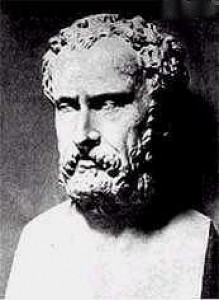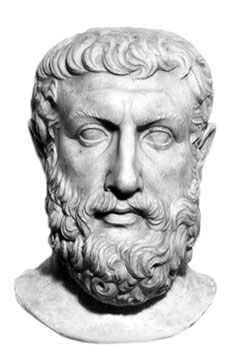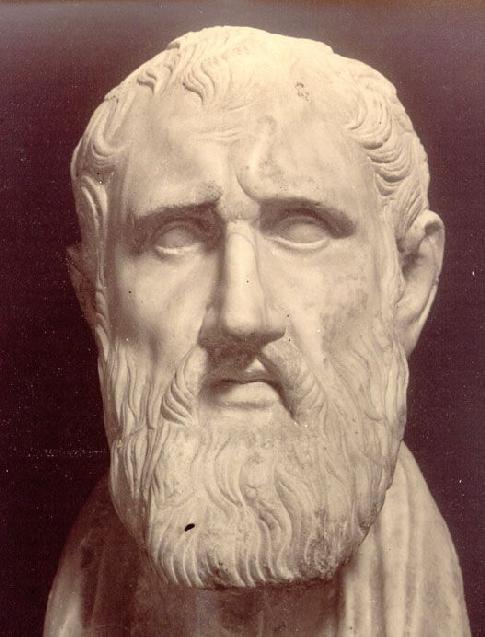Eleatic School
The Eleatic School called after the town of Elea (modern name Velia in south Italy), emphasized the doctrine of the One. The Eleatics defended the unity and stability of the Universe.
Xenophanes

Xenophanes of Colophon, born around 580 B.C.E. is the first we know of to overtly attack the anthropomorphism of popular religious belief, in a series of brilliant reductio ad absurdum arguments. His own view has been understood, ever since Aristotle, as pantheistic. Xenophanes was also the first philosopher we know of to ask what degree of knowledge is attainable. He said: “the clear and certain truth no man has seen; nor will there be anyone who knows about the gods and what I say about all things.” Several ancient critics took this to be an indication of Xenophanes’ total skepticism. But the statement we possess indicates a more restricted range of doubt, encompassing the realm of the divine and perhaps the realm of what we call “natural science”.
Xenophanes of Colophon was a traveling poet and sage with philosophical leanings who lived in ancient Greece during the sixth and the beginning of the fifth centuries BCE. There are a significant number of surviving fragments for such an early figure, and the poetic verses available to us indicate a broad range of issues. These include comments on religion, knowledge, the natural world, the proper comportment at a banquet, as well as other social teachings and commentary.
Xenophanes was from a small town of Colophon in Ionia and most recent scholars place the date of his birth sometime around 570-560 BCE. He appeared to live into his nineties, thereby placing his death sometime after 478 BCE. This is indicated by the following lines from one of Xenophanes’ remaining fragments, which shows him to still be writing poetry at ninety-two years of age.
DownloadParmenides

Parmenides of Elea (510-440 BCE) came from wealthy family and devoted himself to philosophy. Parmenides produced a poem of great density that has been an intellectual challenge since its first appearance, and its meaning still remains much disputed. In distinguishing between a way of truth and a way of seei9ng or opinion (doxa), the poem has seemed to many to argue that the world of perception does not in fact exist and that all we believe about the world is illusory. He affirmed the one unchanging existence to be alone true and capable of being conceived, and multitude and change to be an appearance without reality. Others have held that for Parmenides there are in fact two worlds: one the object of knowledge, the other the object of opinion. Others, more recently, have argued with some plausibility that for Parmenides there is o0nly one world – this one – that can be viewed differently through the synoptic lens of knowledge or the more commonly employed “differentiating” lens of opinion. The same universe seen through the lens of opinion (doxa) is the variegated world of sense experience. Knowledge is attainable only when we view the real synoptically and simply as real.
Parmenides broke with the older Ionic prose tradition by writing in hexameter verse. His didactic poem, called On Nature, survives in fragments, although the Proem (or introductory discourse) of the work has been preserved. Parmenides was a young man when he wrote it, for the goddess who reveals the truth to him addresses him as “youth.” The work is considered inartistic. Its Hesiodic style was appropriate for the cosmogony he describes in the second part, but is unsuited to the arid dialectic of the first. Parmenides was no born poet, and we must ask what led him to take this new departure. The example of Xenophanes’ poetic writings is not a complete explanation; for the poetry of Parmenides is as unlike that of Xenophanes as it well can be, and his style is more like Hesiod and the Orphics. In the Proem Parmenides describes his ascent to the home of the goddess who is supposed to speak the remainder of the verses; this is a reflexion of the conventional ascents into heaven which were almost as common as descents into hell in the apocalyptic literature of those days. Download
Zeno

Zeno of Elea, who was born early in the fifth century B.C.E., was a friend and pupil of Parmenides. In his famous paradoxes he attempted to show by a series of reductio ad absurdum arguments, of which the best known is perhaps that of Achilles and the tortoise, the self-contradictory consequences of maintaining that there is a real plurality of things of that motion or place are real. The prima facie brilliance of many of the arguments continues to impress people, though it soon becomes clear that the paradoxes turn largely on the failure or unwillingness of Zeno, like so many Pythagoreans of the day, to distinguish between the concepts of physical and geometrical space. If the tortoise starts from a point B ahead of Achilles, who is At point A, then when Achilles reaches point B, the tortoise will have moved on to point C. Therefore, Achilles will have to reach an endless number of places where the tortoise has been without ever catching up to him. Achilles will undoubtedly never catch up with the tortoise if he and the tortoise consist of objects in geometrical shape. Similarly, in the arrow paradox, if an arrow moves from A to B, it will have to first move half the distance to B, then half of that distance, and so on. Thus, it will have to reach an endless number of positions to traverse a finite distance in geometrical shape. But in physical space, the space in which activities go on, Achilles does catch up to the tortoise, and we can calculate exactly when that will be, and the arrow does get from A to B.
In the fifth century B.C.E., Zeno of Elea offered arguments that led to conclusions contradicting what we all know from our physical experience–that runners run, that arrows fly, and that there are many different things in the world. The arguments were paradoxes for the ancient Greek philosophers. Because most of the arguments turn crucially on the notion that space and time are infinitely divisible—for example, that for any distance there is such a thing as half that distance, and so on—Zeno was the first person in history to show that the concept of infinity is problematical.
In his Achilles Paradox, Achilles races to catch a slower runner–for example, a tortoise that is crawling away from him. The tortoise has a head start, so if Achilles hopes to overtake it, he must run at least to the place where the tortoise presently is, but by the time he arrives there, it will have crawled to a new place, so then Achilles must run to this new place, but the tortoise meanwhile will have crawled on, and so forth. Achilles will never catch the tortoise, says Zeno. Therefore, good reasoning shows that fast runners never can catch slow ones. So much the worse for the claim that motion really occurs, Zeno says in defense of his mentor Parmanides who had argued that motion is an illusion.
Although practically no scholars today would agree with Zeno’s conclusion, we can not escape the paradox by jumping up from our seat and chasing down a tortoise, nor by saying Achilles should run to some other target place ahead of where the tortoise is at the moment. What is required is an analysis of Zeno’s own argument that does not get us embroiled in new paradoxes nor impoverish our mathematics and science.Download